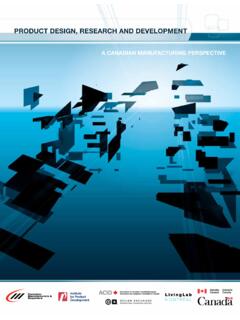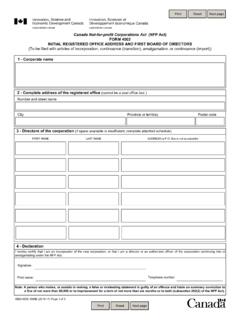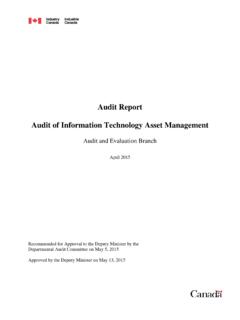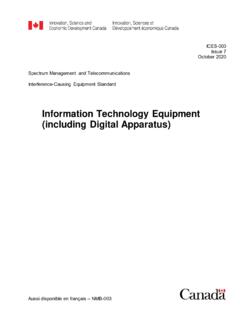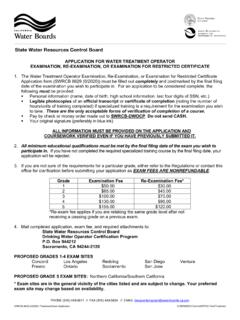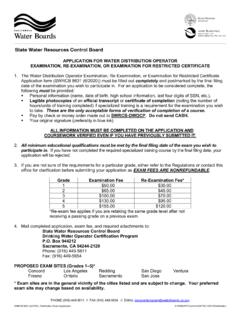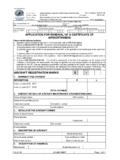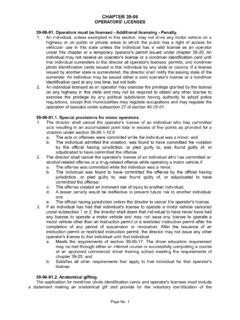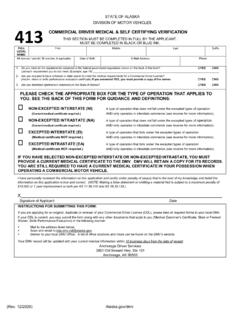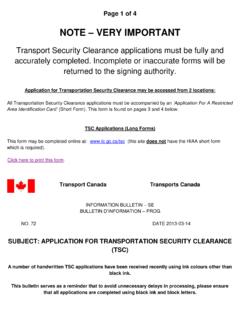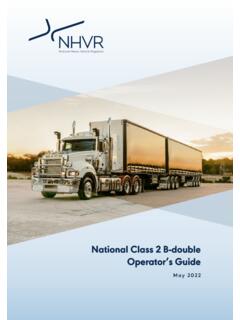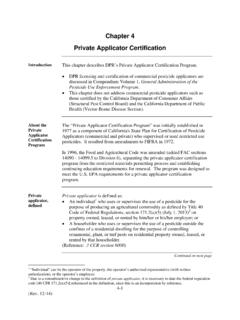Transcription of Study Guide for the Restricted Operator Certificate with ...
1 RIC-21 Issue 3 February 2010 Spectrum Management and TelecommunicationsRadiocommunication Information CircularStudy Guide for the Restricted OperatorCertificate with AeronauticalQualification (ROC-A) Aussi disponible en fran ais CIR-21iPrefaceRadiocommunication Information Circulars are issued for the guidance ofthose engaged in radiocommunications in Canada. The informationcontained in these circulars is subject to change without notice. It istherefore suggested that interested persons consult the nearest districtoffice of Industry Canada for additional details. While every reasonableeffort has been made to ensure accuracy, no warranty is expressed orimplied. As well, these circulars have no status in law. Comments and suggestions may be directed to the following address:Industry CanadaSpectrum Management Operations Branch300 Slater StreetOttawa, Ontario K1A 0C8 Attention: Spectrum Management OperationsE-mail: Spectrum Management and Telecommunications publications areavailable on the following website.
2 Of Communications - Aeronautical of of Communications and Distress Transmission and Phonetic of Words and Calling to be of of Distress of a Distress by Station in by Stations Other than the Station in by Other Stations Hearing a Distress of Receipt of a Distress by Stations Acknowledging Receipt of a Distress of a Distress of of to be of Urgency A - Definitions - Aeronautical B - Procedural Words and C - Equipment D - Radio Station E - Frequency F - Radio Operator Certificate Service Guide for the Restricted Operator Certificate with Aeronautical Qualification (ROC-A) intent of this document is to provide Study information for the ROC-A. Restricted OperatorCertificates are issued for life and no revalidation is required. Contact your local district office ofIndustry Canada if your Certificate is lost or requires ROC-A is required by operators of radiotelephone equipment on board aircraft and at aeronauticalland (fixed and mobile) radio stations using aeronautical mobile frequencies.
3 The radiotelephoneequipment at such stations shall be of a type that requires only simple external switching, has a poweroutput not exceeding 250 watts effective radiated power ( ) equivalent to 400 watts peak envelopepower (PEP) and where all frequency-determining elements are preset within the for the ROC-A are to be conducted by examiners accredited by Industry Canada. These examiners are typically individuals who are engaged in the aeronautical industry. Please visit Industry Canada s website at to find an examiner nearest examination may consist of written, practical and oral exercises. The candidate must satisfy anexaminer that he or she: is capable of operating radiotelephone equipment; possesses a general knowledge of radiotelephone operating procedures and of international regulationsapplicable to the aeronautical service, specifically those regulations relating to the safety of life; and possesses a general knowledge of the Radiocommunication Act and the regulations made are no nationality or age restrictions as to who may take the examination or hold an must attest that they do not have a disability that would impair their ability to operate a radiostation must be presented at the examination.
4 A valid passport, driver s licence, birth Certificate ,baptismal Certificate , citizenship Certificate or landed immigrant identification card will all be acceptedas proof of identity, at the discretion of the Guide for the Restricted Operator Certificate with Aeronautical Qualification (ROC-A) of Communications - Aeronautical ServiceThe order of priority for transmission of messages in the aeronautical service relating to radio safety regularity relating to the application of the United Nations messages for which priority has been expressly communications relating to the workings of the telecommunication service or tocommunications previously other aeronautical of CommunicationsRadio operators and all persons who become acquainted with radiocommunications are bound topreserve the privacy of those communications. In accordance with subsection 9(2) of theRadiocommunication Act, no person shall divulge the contents, or the existence, of communicationstransmitted, received or intercepted by a radio station, except as permitted by the addressee of themessage or his/her accredited agent, or to authorized officials of the Government of Canada, officers ofthe court or an Operator of a telecommunications system as is necessary to forward or deliver thecommunication.
5 These restrictions do not apply to a message of distress, urgency, safety or to messagesaddressed to ALL STATIONS ( weather reports, storm warnings, etc.).As outlined in section of the Act, any person who violates the privacy of communications is liable,on summary conviction, in the case of an individual, to a fine not exceeding twenty-five thousand dollarsor to imprisonment for a term not exceeding one year, or to both, or, in the case of a person other than anindividual, on summary conviction, to a fine not exceeding seventy-five thousand Guide for the Restricted Operator Certificate with Aeronautical Qualification (ROC-A) of CommunicationsIn communications between aeronautical ground stations and aircraft stations, the aircraft station shallcomply with instructions given by the ground station in all matters relating to the order and time oftransmission, the choice of frequency and the duration and suspension of communications. This does notapply in the cases of distress or urgency communications, where the control lies with the stationinitiating the priority operation of an aircraft station is under the control of the pilot or another person in charge of the communications between aeronautical ground stations and aircraft stations, it is normally the groundstation that retains communications control.
6 In communications between aircraft stations, however, theaircraft station being called is the controlling the station called is in agreement with the calling station, it shall transmit an indication that from thatmoment onwards it will listen on the working frequency or channel announced by the calling , if the station called is not in agreement with the calling station on the working frequency orchannel to be used, it shall transmit an indication of the working frequency or channel to be :(a)Ground station calling an aircraft (the ground station has control of radiocommunications)PIPER CHARLIE FOXTROT X-RAY QUEBEC QUEBECTHIS ISOTTAWA RADIOGO AHEAD ON TOWER FREQUENCY ONE TWO TWO DECIMAL ONEOVER(b)Aircraft calling a ground station (the ground station has control of radiocommunications)OTTAWA RADIOTHIS ISPIPER CHARLIE FOXTROT X-RAY QUEBEC QUEBECON FREQUENCY ONE TWO TWO DECIMAL ONEOVER(c)One aircraft to another aircraft (the aircraft being called has control of radiocommunications)CESSNA CHARLIE FOXTROT X-RAY QUEBEC TANGOTHIS ISPIPER CHARLIE FOXTROT X-RAY QUEBEC QUEBECON FREQUENCY ONE ONE NINE DECIMAL SEVENOVERS tudy Guide for the Restricted Operator Certificate with Aeronautical Qualification (ROC-A)
7 RIC-214 PIPER CHARLIE FOXTROT X-RAY QUEBEC QUEBECTHIS ISCESSNA CHARLIE FOXTROT X-RAY QUEBEC TANGOCHANGE TO SEARCH AND RESCUE FREQUENCY ONE TWOTHREE DECIMAL Communications and InterferenceRadiocommunications between aeronautical stations should be Restricted to those relating to safety andflight regularity. In accordance with subsection 32(1) of the Radiocommunication Regulations,superfluous communication, as well as profane and obscene language, is strictly person who violates the regulations relative to unauthorized communications, profane or obscenelanguage is liable, on summary conviction, in the case of an individual, to a fine not exceeding fivethousand dollars or to imprisonment for a term not exceeding one year, or to both, or, in the case of acorporation, on summary conviction, to a fine not exceeding twenty-five thousand Act clearly states that all radio stations shall be operated so as not to interfere with or interrupt theworking of another radio station.
8 The penalties for doing so are the same as those noted above. The onlysituation under which you may interrupt or interfere with the normal working of another station is whenyou are required to transmit a higher priority call or message, for example, distress, urgency or otherpriority calls or Distress SignalsParagraph 9(1)(a) of the Act clearly states that no person shall knowingly send, transmit, or cause to besent or transmitted any false or fraudulent distress signal, message, call or radiogram of any for this offence, on summary conviction, in the case of an individual, can include a fine notexceeding five thousand dollars or imprisonment for a term not exceeding one year, or to both, or, in thecase of a corporation, to a fine not exceeding twenty-five thousand Transmission TechniquesThe efficient use of radio depends to a large extent on the method of speaking and on the articulation ofthe Operator . As the distinctive sounds of consonants are liable to become blurred in the transmission ofspeech and as words of similar length containing the same vowel sounds are apt to sound alike, specialcare is necessary to ensure their proper using radio, the Operator should speak all words plainly and clearly to prevent words from runningtogether.
9 Avoid any tendency to shout, accent syllables, or to speak too rapidly. The following pointsshould be kept in mind when using radio: Study Guide for the Restricted Operator Certificate with Aeronautical Qualification (ROC-A)RIC-215 Speed:Keep the rate of speech constant, neither too fast nor too slow. Remember that the operatorreceiving your message may have to write it :Preserve the rhythm of ordinary conversation and word pronunciation. Also, avoid theintroduction of unnecessary sounds such as er and um between and DateThe twenty-four hour clock system should be used to express time during radiocommunications. Timeshould be expressed and transmitted by means of four figures, the first two denoting the hour pastmidnight and the last two the minutes past the :12:45 expressed as 004512:00 noonis expressed as 120011:45 expressed as 234512:00 midnightis expressed as 2400 or 00001:30 expressed as 01301:45 expressed as 13454:30 expressed as 1630 Time is usually referenced to one standard time zone, Coordinated Universal Time (UTC) (often referredto as Greenwich Mean Time (GMT) or zulu time (Z)) to avoid confusion between different time operations are conducted solely in one time zone, local time may be the date, as well as the time of day, is required, a six-figure group should be used.
10 The first twofigures indicate the day of the month and the following four figures indicate the :Noon (EST) of the 16th day of the month is expressed E2:45 (PST) of the 24th day of the month is expressed Phonetic AlphabetThe phonetic alphabet adopted by the International Telecommunication Union (ITU) is used to avoidconfusion when transmitting difficult or unusual words. This internationally recognized alphabet shouldbe learned so that it is readily available whenever isolated letters or groups of letters are pronouncedseparately, or when communication is difficult. Call signs should also be spelled Guide for the Restricted Operator Certificate with Aeronautical Qualification (ROC-A)RIC-216 The ITU phonetic alphabet is:LetterWordPronounced asAAlfaAL FAHBB ravoBRAH VOHCC harlieCHAR LEE or SHAR LEEDD eltaDELL TAHEEchoECK OHFF oxtrotFOKS TROTGGolfGOLFHH otelHOH TELLII ndiaIN DEE AHJJ uliettJEW LEE ETTKKiloKEY LOHLLimaLEE MAHMMikeMIKENN ovemberNO VEM BEROO scarOSS CAHPPapaPAH PAHQQ uebecKEH BECKRR omeoROW ME OHSS ierraSEE AIR RAHTT angoTANG GOUU niformYOU NEE FORM or OO NEE FORMVV ictorVIK TAHWW hiskeyWISS KEYXX-rayECKS RAYYY ankeeYANG KEYZZuluZOO LOONote:The syllables to be emphasized are in are pronounced as follows.



